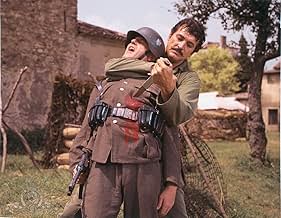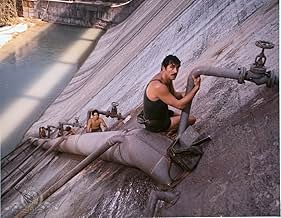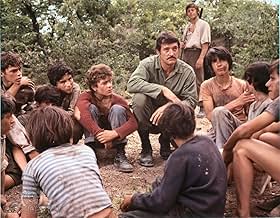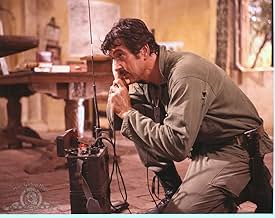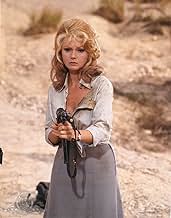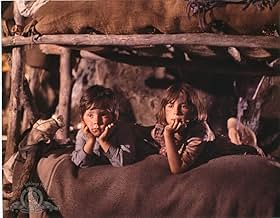VALUTAZIONE IMDb
5,8/10
1197
LA TUA VALUTAZIONE
Aggiungi una trama nella tua linguaIn 1944, during a sabotage mission, the sole surviving U.S. paratrooper is saved by a group of Italian orphans who later aid him in blowing up a vital enemy dam.In 1944, during a sabotage mission, the sole surviving U.S. paratrooper is saved by a group of Italian orphans who later aid him in blowing up a vital enemy dam.In 1944, during a sabotage mission, the sole surviving U.S. paratrooper is saved by a group of Italian orphans who later aid him in blowing up a vital enemy dam.
- Regia
- Sceneggiatura
- Star
Giacomo Rossi Stuart
- Schwalberg
- (as Giacomo Rossi-Stuart)
Recensioni in evidenza
I was flipping channels and came upon Hornet's Nest. I thought I was watching Force 10 From Navarone (no digital cable) until the hospital scene. The movie had elapsed 20 minutes but for some reason I was drawn into the story. There was quite a lot of carnage in the movie and I hope I had to assume that Rock raped the doctor lady. The real character that you have to clap for is the German Captain that was dissed by all his superiors pretty much for the whole movie when he was just doing his job in the best interest of the Fatherland.
I went through all possible emotions during the flick and was overall happy with the movie having never seen it before. I had to log onto the database to know it's title which brings me to making my comments. I give it a 7.
I went through all possible emotions during the flick and was overall happy with the movie having never seen it before. I had to log onto the database to know it's title which brings me to making my comments. I give it a 7.
It has been argued the Germans during World War Two made a number of mistakes with the various countries they conquered. In some cases, those mistakes were colossal. Take this film for instance. It's called " Hornets Nest " and takes place in 1944, near Reanoto, Italy. The small village is suspected of aiding the Partisans. These guerrilla, groups have become so annoying to the Germans, the local military Italian governor is replaced by a brutal SS Officer. Upon reaching the town, he rounds up the villagers and order them to reveal the Partisans upon pain of death. Bad mistake, but one which the Germans inflict with Nazi efficiency. Their children, learn the US military is sending a team of Commandos to destroy the dam near the town. The SS discover the drop zone and massacre all the airborne troops except one. The single survivor called Turner (Rock Hudson) awakens from his wounds and discovers he owes his life to a group of Teenage boys. Informed the SS is searching for him, Turner also learns an experience German Officer name Von Hecht (Sergio Fantoni) is also closing in on his whereabouts. Realizing, he has little choice, Turner decides to use his hate-filled and revenge seeking youths to continue his mission to destroy the dam. Accompanying him is a kidnapped female doctor (Sylva Koscina) who reluctantly joins the group. The movie itself is interesting in that instead of battle hard soldiers, Hudson has to first teach the kids to kill and then later must reverse his lessons. To the credit of the young cast, the teens lead by vengeance seeking Aldo (Mark Colleano) do a remarkable job of acting. From deep sorrow to hate spewing machine-gun scenes, they add to the over the top drama. In all, this action film does an honest job of creating a military Classic. However, much as I enjoy Hudson the actor, I can't help feel Charles Bronson or Burt Lancaster would have been a better choice as Husdon is not convincing as a rapist of women or abuser of children. ****
Following the massacre of a village for collaborating with the resistance in northern Italy, the remaining children remain in hiding causing as much trouble as they can. When a commando group helped by the resistance are themselves all killed, the only surviving soldier Turner (Rock Hudson) decides to use the children to help him blow up a nearby dam. The area is of course swarming with Germans, lead by a fanatical Captain Von Hecht (Sergio Fantoni).
Odd war film with tough guy Rock Hudson determined to blow the dam but partly hampered by the boys, who, whilst willing to help are more interested in revenge for the massacre, particularly their leader Aldo who is waging his only private little war - give and take then becoming a necessity. As a story that just about hangs together, in large part because of a strong convincing turn by Hudson who is tough, even cruel and far from a father figure other films might have gone for.
The main difficulty here is whether the idea is convincingly portrayed and whether you even buy into such a thing. Overall I'd say it just about makes it over the line, just, although in the minus column the film is prone to melodrama / overacting, it looks like it's filmed on a backlot and the Germans here are portrayed as entirely incompetent..
Odd war film with tough guy Rock Hudson determined to blow the dam but partly hampered by the boys, who, whilst willing to help are more interested in revenge for the massacre, particularly their leader Aldo who is waging his only private little war - give and take then becoming a necessity. As a story that just about hangs together, in large part because of a strong convincing turn by Hudson who is tough, even cruel and far from a father figure other films might have gone for.
The main difficulty here is whether the idea is convincingly portrayed and whether you even buy into such a thing. Overall I'd say it just about makes it over the line, just, although in the minus column the film is prone to melodrama / overacting, it looks like it's filmed on a backlot and the Germans here are portrayed as entirely incompetent..
I saw this film many years ago when it was panned because children were being used in a war movie. That attitude reflected the times in which it was produced.
People wanted Anti War movies like "The Deer Hunter" or heroic battle epics like "Tora, Tora, Tora".
Movies that brought the stark reality of war too near were not well received.
"Hornet's Nest", was made in Italy and like the movie, "Two Women", made ten years before, it was not widely popular in the United States. Although "Two Women", gave Sophia Loren new respect as an actress and received an Oscar for Best Foreign Film, it did not receive favor from the public.
The patriotism of World War II had faded by the 1970's and the public demonstrations against Viet Nam were gaining force when "Hornets Nest" was released. It was seen as a glorification of war and a fading star like Rock Hudson could not save it.
Ironically one of the actors playing an SS officer in the movie was a French Partisan who spent a year in Buchenwald after the Nazi's captured him. The one female star, Sylvia Koscina, was a child in Yugoslavia, during the war and had memories of the Nazi occupation.
Sophia Loren began filming this movie and withdrew because it recalled too much of the trauma of her childhood in war time Italy.
The children who made this movie did a good job of showing the effect of war on young minds. In spite of being little more than amateurs the acting was capable. The one young actor who was professional, Mark Colleano, was particularly talented. He played Aldo , the leader of the partisan children. His last scene brought tears to my eyes.
It was not intended to be an easy picture to watch. Those reviewers who made snide remarks about Rock Hudson's sexual preferences and the nudity of the teen and child actors in the movie were simply revealing their own salacious nature. They deliberately missed the point.
In retrospect this film was made before it's time. Based on actual events where Nazi troops committed atrocities against entire villages it was meant to remind the world of the savagery of a totalitarian military that had absolute control over the lives of helpless populations. It foreshadowed the massacres committed by the Soviet troops who took over Eastern Europe and much of the territory bordering the USSR. Massacres in Hungary, and in Poland and the building of the Berlin Wall
Since then we have seen movies like "Schindler's List", "Hotel Rwanda", "The Killing Fields" and "Empire of the Sun", win awards. They all show the atrocity and dehumanizing effects of war in a much more graphic manner than does "Hornets Nest", as do many, many, other well respected films. Though "Hornet's Nest" can't compare in quality to them it did not have the budget nor the huge cast they had either.
In the years since " Hornets Nest", the world has been treated to Bosnia, Rwanda, Somalia, and Serbia, where women and children are victims and participants in total warfare. It prefaced the time of child soldiers who watch their families slaughtered and go on to commit unspeakable acts themselves.
All of these years later this picture is still relevant. Children become partisan fighters much like the boys in this film. Children turn themselves into human bombs or carry guns for ISIS. Boy soldiers live and die in the jungles of the Philippines or as pirates off the coast of Somalia.
Savage child soldiers in Africa showed the whole world how easy it is to create baby-killers and how hard it is to return them to what they once were, Children.
In Afghanistan, Syria, Yemen, Libya, children are carrying weapons and fighting as adults. Boys and girls are being robbed of both their childhood and their future.
I watched "Hornets Nest" again tonight and it brought tears to my eyes. These children, dirty, ragged, hungry orphans, had managed to survive and had taken vengeance on their tormentors, but in doing so, they had lost something irreplaceable. They had lost their innocence and a part of their humanity. Although they survived they were truly victims of a terrible war.
Maybe watching this movie in todays context makes the point it did not when it was first released. War is bad for children and other living things.
Being safe and smug in a country free from these things, we can put our children to bed with out fear of bombs or machine guns waking them. But in many parts of the world that is not the case.
So is this movie so ridiculous? Is it so unrealistic? Is it a joke because Rock Hudson turned out to be a Gay man?
I don't think so. I think the movie deserves a respectful viewing and some recognition at long last.
The movie emerges from a period in which World War II cinema was undergoing a crucial transition. The late 1960s and early 1970s saw a growing fatigue with the glorification of war; the trauma of Vietnam had begun to influence how audiences and filmmakers alike viewed armed conflict, pushing war films into more ambiguous, morally grey territories. This film is a product of that in-between moment - still shaped by the action-adventure expectations of mid-century war cinema, yet increasingly marked by a grim, introspective undercurrent, particularly evident in its unorthodox choice of protagonists and unsettling psychological tone.
Cinematically, the film is shot with a utilitarian clarity. The cinematography opts for a functional realism that, while rarely inspired, serves the narrative's harsh thematic direction. There is a certain arid starkness to the Italian landscapes standing in for northern Italy during the German occupation, which contrasts interestingly with the narrative's descent into psychological murk. The film avoids the lush, panoramic compositions typical of war spectacles like The Guns of Navarone (1961) or Where Eagles Dare (1968). Instead, it deploys a more intimate framing that brings the viewer uncomfortably close to the tension between its characters, particularly in the scenes involving the band of orphaned boys who shift rapidly from victimhood to violent agency.
The sound design and musical score feel almost intrusive at times - not in their volume or instrumentation, but in the way they often seem to be doing narrative work that the image struggles to shoulder. There's a persistent sense that the film's score is trying to orient the viewer emotionally toward a kind of mythologized heroism, but it remains in uneasy conflict with the disturbing implications of the boys' transformation under the guidance of an American saboteur. This contrast between audio and visual tone is dissonant, though perhaps not unintentionally so, highlighting the thematic instability at the film's core. It's also worth noting that the choice of Ennio Morricone as composer, while striking on paper, might not have been entirely suitable for the demands of this film. His musical voice, so effective in stylized, psychologically expressive or operatic narratives, often overwhelms subtler textures and is less at ease in depicting the grim, ambiguous realism that this particular story might have benefited from. The score seems at times too melodically insistent, almost too poetic for the brutal, morally jagged landscape the film inhabits.
Performance-wise, the film hinges on a difficult axis: an adult lead who must project both authority and inner fracture, and a group of child actors tasked with portraying a complex moral unraveling. The former delivers a portrayal that, while occasionally veering toward the melodramatic, maintains a credible tension between military professionalism and ethical disintegration. The children, however, vary in effectiveness. The unevenness of their performances underscores the film's uneasy balance between pulp adventure and moral fable - a duality it never entirely resolves. This lack of resolution could be read as a weakness, but within the war film subgenre focusing on sabotage and resistance in occupied territories, this ambiguity can also be understood as deliberate, reflecting the ideological tensions of the era in which the film was made.
Comparatively, The Train (1964) offers a sharper, more technically precise take on sabotage operations in Nazi-occupied Europe, grounding its narrative in a more industrial, material world - rail yards, cargo, and logistical resistance - whereas this film leans toward a more psychological and symbolic framework. The Train also maintains a tighter control of tone and pacing, never allowing the action to obscure the deeper questions of value and sacrifice. In contrast, Hornets' Nest pushes its moral inquiry through a kind of allegorical brutality, sacrificing tonal coherence for thematic provocation.
There's also an evident thematic kinship with Play Dirty (1969), another WWII sabotage narrative that resists romanticism, favoring moral corrosion and ambiguous motives. Both films share an interest in how war reshapes identities and erodes any stable definition of heroism, though this film ventures further into uncomfortable territory by placing children at the moral center. Unlike Play Dirty, which presents adult cynicism and duplicity as inevitable in wartime, this film's horror lies in the corruption of innocence - a stark, unsettling deviation from the more typical soldier's journey narrative.
Technically, the editing reveals some of the production's limitations. Transitions can be abrupt, and the spatial geography of action scenes is not always clearly established. This occasionally compromises narrative tension, particularly during the more chaotic sequences. Nevertheless, these rough edges contribute to a sense of instability that mirrors the psychological disintegration at play.
Adding to this fragility is the question of historical verisimilitude. Certain period details - such as the boys' haircuts, the condition and cut of their clothing, and even their body language - undermine credibility, reminding the viewer that this is still a film of its era, made within the aesthetic and technical constraints of 1970. These anachronisms may seem minor, but in a film that already demands a large suspension of disbelief, particularly in its depiction of children effortlessly carrying out guerrilla-style attacks and the almost mythical invincibility of their American mentor, such cracks in the surface become more conspicuous. The ease with which the protagonists dismantle German positions - including a barracks and a dam checkpoint - strains credibility even within the conventions of war cinema. The American saboteur borders on the archetype of a pre-Rambo figure, a super-soldier whose capabilities dwarf any plausible military realism. This heroic exaggeration undermines the otherwise sobering psychological and moral themes the film attempts to explore.
All of this contributes to a sense that the film has something substantial at its core - an idea with real weight and moral discomfort - but lacks the cohesion and finesse to fully bring it to maturity. It is as if it falls just short of being the film it aspires to be. Still, there is something undeniably compelling about its ambition. Within the subgenre of WWII sabotage and resistance films, it stands out for its unique thematic choice: children not just as witnesses to war but as its instruments, shaped and twisted by the brutality surrounding them.
From a purely cinematographic perspective, one might lean toward giving the film 6 stars out of 10 - acknowledging its originality and daring, while also recognizing its technical and narrative shortcomings. However, when accounting for its thematic boldness, the singularity of its premise within the genre, and the lingering impact of its moral ambiguities, it can reasonably earn a 7. It may be flawed in execution, but it offers something rare: a war film that doesn't flatter the myths of heroism, and instead drags the viewer into a deeply uncomfortable confrontation with the idea of what war - even a "just" war - can do to those forced to grow up inside it. In fact, the strength of its central idea is such that one can't help but feel this is a film that deserves a serious remake - one that could preserve the disturbing moral core while refining the technical weaknesses and grounding the action in a more believable context. With the right tone and craftsmanship, the story could finally reach the full cinematic depth that the original screenplay was straining toward but never quite attained.
Cinematically, the film is shot with a utilitarian clarity. The cinematography opts for a functional realism that, while rarely inspired, serves the narrative's harsh thematic direction. There is a certain arid starkness to the Italian landscapes standing in for northern Italy during the German occupation, which contrasts interestingly with the narrative's descent into psychological murk. The film avoids the lush, panoramic compositions typical of war spectacles like The Guns of Navarone (1961) or Where Eagles Dare (1968). Instead, it deploys a more intimate framing that brings the viewer uncomfortably close to the tension between its characters, particularly in the scenes involving the band of orphaned boys who shift rapidly from victimhood to violent agency.
The sound design and musical score feel almost intrusive at times - not in their volume or instrumentation, but in the way they often seem to be doing narrative work that the image struggles to shoulder. There's a persistent sense that the film's score is trying to orient the viewer emotionally toward a kind of mythologized heroism, but it remains in uneasy conflict with the disturbing implications of the boys' transformation under the guidance of an American saboteur. This contrast between audio and visual tone is dissonant, though perhaps not unintentionally so, highlighting the thematic instability at the film's core. It's also worth noting that the choice of Ennio Morricone as composer, while striking on paper, might not have been entirely suitable for the demands of this film. His musical voice, so effective in stylized, psychologically expressive or operatic narratives, often overwhelms subtler textures and is less at ease in depicting the grim, ambiguous realism that this particular story might have benefited from. The score seems at times too melodically insistent, almost too poetic for the brutal, morally jagged landscape the film inhabits.
Performance-wise, the film hinges on a difficult axis: an adult lead who must project both authority and inner fracture, and a group of child actors tasked with portraying a complex moral unraveling. The former delivers a portrayal that, while occasionally veering toward the melodramatic, maintains a credible tension between military professionalism and ethical disintegration. The children, however, vary in effectiveness. The unevenness of their performances underscores the film's uneasy balance between pulp adventure and moral fable - a duality it never entirely resolves. This lack of resolution could be read as a weakness, but within the war film subgenre focusing on sabotage and resistance in occupied territories, this ambiguity can also be understood as deliberate, reflecting the ideological tensions of the era in which the film was made.
Comparatively, The Train (1964) offers a sharper, more technically precise take on sabotage operations in Nazi-occupied Europe, grounding its narrative in a more industrial, material world - rail yards, cargo, and logistical resistance - whereas this film leans toward a more psychological and symbolic framework. The Train also maintains a tighter control of tone and pacing, never allowing the action to obscure the deeper questions of value and sacrifice. In contrast, Hornets' Nest pushes its moral inquiry through a kind of allegorical brutality, sacrificing tonal coherence for thematic provocation.
There's also an evident thematic kinship with Play Dirty (1969), another WWII sabotage narrative that resists romanticism, favoring moral corrosion and ambiguous motives. Both films share an interest in how war reshapes identities and erodes any stable definition of heroism, though this film ventures further into uncomfortable territory by placing children at the moral center. Unlike Play Dirty, which presents adult cynicism and duplicity as inevitable in wartime, this film's horror lies in the corruption of innocence - a stark, unsettling deviation from the more typical soldier's journey narrative.
Technically, the editing reveals some of the production's limitations. Transitions can be abrupt, and the spatial geography of action scenes is not always clearly established. This occasionally compromises narrative tension, particularly during the more chaotic sequences. Nevertheless, these rough edges contribute to a sense of instability that mirrors the psychological disintegration at play.
Adding to this fragility is the question of historical verisimilitude. Certain period details - such as the boys' haircuts, the condition and cut of their clothing, and even their body language - undermine credibility, reminding the viewer that this is still a film of its era, made within the aesthetic and technical constraints of 1970. These anachronisms may seem minor, but in a film that already demands a large suspension of disbelief, particularly in its depiction of children effortlessly carrying out guerrilla-style attacks and the almost mythical invincibility of their American mentor, such cracks in the surface become more conspicuous. The ease with which the protagonists dismantle German positions - including a barracks and a dam checkpoint - strains credibility even within the conventions of war cinema. The American saboteur borders on the archetype of a pre-Rambo figure, a super-soldier whose capabilities dwarf any plausible military realism. This heroic exaggeration undermines the otherwise sobering psychological and moral themes the film attempts to explore.
All of this contributes to a sense that the film has something substantial at its core - an idea with real weight and moral discomfort - but lacks the cohesion and finesse to fully bring it to maturity. It is as if it falls just short of being the film it aspires to be. Still, there is something undeniably compelling about its ambition. Within the subgenre of WWII sabotage and resistance films, it stands out for its unique thematic choice: children not just as witnesses to war but as its instruments, shaped and twisted by the brutality surrounding them.
From a purely cinematographic perspective, one might lean toward giving the film 6 stars out of 10 - acknowledging its originality and daring, while also recognizing its technical and narrative shortcomings. However, when accounting for its thematic boldness, the singularity of its premise within the genre, and the lingering impact of its moral ambiguities, it can reasonably earn a 7. It may be flawed in execution, but it offers something rare: a war film that doesn't flatter the myths of heroism, and instead drags the viewer into a deeply uncomfortable confrontation with the idea of what war - even a "just" war - can do to those forced to grow up inside it. In fact, the strength of its central idea is such that one can't help but feel this is a film that deserves a serious remake - one that could preserve the disturbing moral core while refining the technical weaknesses and grounding the action in a more believable context. With the right tone and craftsmanship, the story could finally reach the full cinematic depth that the original screenplay was straining toward but never quite attained.
Lo sapevi?
- QuizThe film is based on a true World War II incident that occurred when the German army was making its last stand in Italy.
- BlooperWhen the German Major and German Captain enter the radio room after the raid on the village, the radioman 'corpse' in the chair clearly takes several quick controlled breaths by breathing with his abdomen, then visibly swallows, right before he starts holding his breath. He is immediately knocked out of his chair and out of frame off screen by the Captain, probably to prevent more visible breathing from a corpse on the film.
- ConnessioniReferenced in Django Unchained (2012)
I più visti
Accedi per valutare e creare un elenco di titoli salvati per ottenere consigli personalizzati
- How long is Hornets' Nest?Powered by Alexa
Dettagli
- Data di uscita
- Paesi di origine
- Lingue
- Celebre anche come
- Children at Their Games
- Luoghi delle riprese
- Gazzola, Provincia di Piacenza, Emilia-Romagna, Italia(Castello di Rivalta)
- Aziende produttrici
- Vedi altri crediti dell’azienda su IMDbPro
Contribuisci a questa pagina
Suggerisci una modifica o aggiungi i contenuti mancanti


